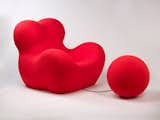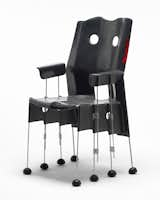Gaetano Pesce, the groundbreaking designer known for furniture and objects that blend utility with vibrant eccentricity has died at age 84.
In his 40-year career, Pesce helped move 20th-century modernism’s right angles into a new era of complexity. His architectural practice produced both built and speculative projects featuring dynamic systems and ornamentation: In Osaka, Japan, his Organic Building (1993) consists of nine stories of residential apartments clad in vibrant steel panels that hold small, bulbous bays for growing plants. The cladding conceals a complex irrigation system that maintains the vertical garden.
Arguably his greatest impact was in industrial design, where he blended a functional, architectural vision with materials that spoke to the future—most notably using polyurethane resin. He spoke to Dwell in 2016 about discovering the material in his youth and, taking inspiration from the growing technologies around him, deployed the resin in inventive forms.
His Up5 Chair, which debuted in 1969, molds polyurethane into a voluminous, curvaceous lounge seat with an attached spherical ottoman. The shape references an existential female imprisonment, he said. “Despite herself, the woman has always been her own prisoner,” Pesce told Dwell in 2019. “I wanted to give this armchair a feminine form with a ball at the foot, which also represents the traditional image of the prisoner.”
Though his practice in objects and furniture was inherently utilitarian, it exuded poetics—a means of disrupting rationalism inherent to industrial design. Such social and political commentary speaks to Pesce’s ability to transcend the decorative. “When an object‚ in addition to practical values, expresses transcendental values, such as philosophical‚ religious‚ political ones, it then becomes art,” he told Dwell in 2019.
In a 2018 Columbia GSAPP Conversations podcast episode, he spoke with student Luiza Furia about teaching to elicit such politics: he described how he would assign students to design a palace for the Chilean dictator Pinochet and Stalin. How each student might take their own position on the assignment, based on their political and personal values, would influence their approach to design.
Pesce vases at the Italian Cultural Institute of Los Angeles in 2010













